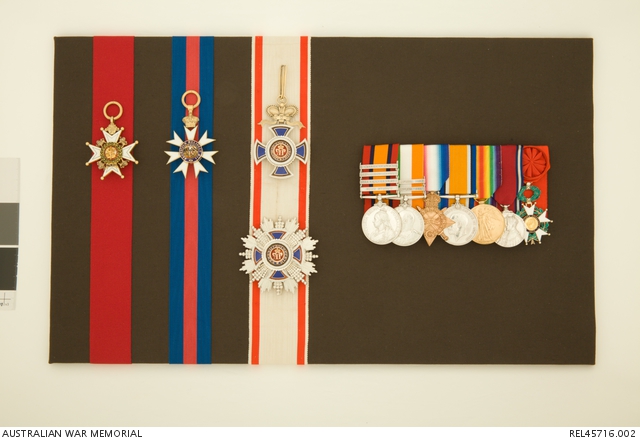| Place | Oceania: Australia |
|---|---|
| Accession Number | REL45716.002 |
| Collection type | Heraldry |
| Object type | Award |
| Physical description | Enamel, Silver gilt |
| Location | Main Bld: First World War Gallery: Western Front 1916: Pozieres |
| Maker |
Unknown |
| Place made | United Kingdom |
| Date made | c 1912 |
| Conflict |
Army organisation period 1903-1912 |
Neck badge of Companion of the Order of St Michael and St George : Lieutenant Colonel J G Legge, Quartermaster General, AMF


Neck badge of Companion of the Order of St Michael and St George. Unnamed as issued.
The award of the Companion of the Order of St Michael and St George to Lieutenant Colonel James Gordon Legge resulted from his work in instituting Australia’s first universal training scheme. Born in London in 1863, Legge emigrated with his family to Australia in 1878. His long association with the military began while he was studying for his law degree at the University of Sydney in 1885 when he was commissioned an officer with the 3rd NSW Infantry Regiment. Graduating in 1890 he abandoned his law career in favour of a permanent position as a captain with the NSW Military Forces in 1894.
As early as 1889 Legge recognised the importance of a well disciplined and efficient military when he became an inaugural member of the NSW branch of the United Services Institute (USI), an academy based on a British model to enhance the professionalism among the ranks of the colonies’ military officers.
A decade later Legge first presented his idea of a compulsory peacetime military training scheme in a paper to the USI; 'Suggestions for an Australian Defence Force'. 'If war ever reached our shores', wrote Legge in defence of his scheme, 'we must depend on our citizen soldiers, and according to high authorities our forces would be incapable of making solid resistance.' From a population of three million people, Legge proposed a scheme of training a militia force of 90000 men, with those that were found unsuitable for training to pay an exemption tax, 'according to their means' to help defray costs. A few months after presenting his paper Legge left for service in South Africa and returned in 1902.
By 1905, Legge was again warning of the unpreparedness of Australia in the event of an invasion. He estimated that the country had approximately 48000 men in its militia units and this, he advised, would be sufficient to defend against a raid on a defended port…'by a few battleships or cruisers with a small force'. A full invasion, however, 'would be a military undertaking of no serious difficulty' for an invading force. While he put forward a far less ambitious scheme of better organised, trained and equipped rifle clubs, the idea of a universal scheme was being advanced by senior state officers and community leaders.
In 1907 the Deakin Government proposed the introduction of compulsory training and Legge was the logical choice to design an appropriate scheme and, with his legal training, to draft a Bill to introduce to Parliament. Following much debate, amendments, and a change of government, Legge’s Bill was finally made into law on 13 December 1909. It came into effect on 1 July 1911. The 'Defence Act 1909' required all Australian males aged between 12 and 26, with certain exemptions, to either undergo training and/or perform militia service within Australia and its territories. The scheme was abolished in 1929.
Legge was recognised for his work in the formation of the scheme after its implementation in 1911, with the award of a Companion of the Order of St Michael and St George.
Though Legge went on to command, with some distinction, the 1st then the 2nd Australian Divisions on Gallipoli and in France during the First World War, he was perceived as a problematic commander and he returned to Australia in 1917 to more administrative roles.
On 4 October 1918, he was dealt a severe blow when his eldest son, Private George Ferguson Legge, was killed in action fighting near Montbrehain with 22 Battalion. Between 1920 and 1922 Legge was commandant of the Royal Military College, Duntroon during a difficult period of severe budget cuts and military restructuring. His long military career effectively ended when he was placed on the Unattached List on 1 August 1922 due to defence force reductions. He was eventually placed on the Retired List with the honorary rank of lieutenant-general in January 1924. The following month he was awarded the French Legion of Honour.
Although his career spanned over more than three decades, he failed to reach the prescribed retirement age and was denied a pension. With assistance from the post-war soldier settlement scheme he was able to retire to Cranleigh Farm at Weetangera near Canberra where he became a virtual recluse. He died in Melbourne on 18 September 1947.